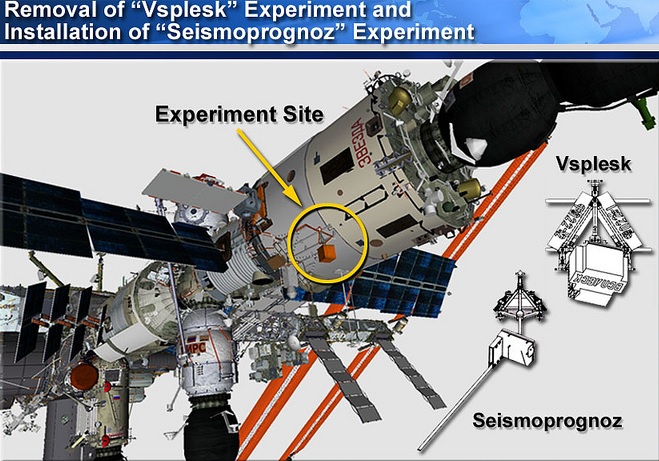Оборудование для научных экспериментов: «Сейсмопрогноз», «Биодеградация», «Матрёшка-Р», «Термо-ЛАДА», «СПЛАНХ», «Капля-2», НА Баблл-дозиметр, Моноблок камеры высокого разрешения, Моноблок камеры среднего разрешения.
Flight Engineers Sergey Ryazanskiy and Mikhail Tyurin spent their morning installing hardware and routing cables in the Zvezda service module for Seismoprognoz, a Russian experiment that seeks to develop and validate techniques for monitoring the precursors of earthquakes, which could lead to a global earthquake prediction system.
 Flickr: NASA: 2Explore's Photostream |
after 2:10 |
In addition to their work with the two cameras, the spacewalkers also removed the Vsplesk experiment package and jettisoned it. Vsplesk, installed during an Expedition 17 spacewalk in July 2008, was designed to monitor seismic effects using high-energy particle streams in the near-Earth environment. Kotov and Ryazanskiy replaced it with hardware for a more sophisticated earthquake-monitoring experiment, Seismoprognoz, which they attached to a Zvezda handrail.
And gone! Vsplesk has been jettisoned to make room for the Seismoprognoz payload that will be installed next. #ISS pic.twitter.com/PCoZWrYtZO
— ISS Updates (@ISS101) 2013, 12月 27国際宇宙ステーションで作業中のロシアのオレグ・コトフ飛行士とセルゲイ・リャザンスキイ飛行士は、今年2013年にロシアのセグメント・プログラムで計画された最後の船外活動を成功裏に終えた。今年ロシア人飛行士らは6度、船外活動をし、その合計時間は8時間5分に達し新記録となった。なおすべての船外活動は、首尾よく成し遂げられている。
またコトフ及びリャザンスキイ両飛行士は、宇宙実験モノブロック「セイスモプログノス」の取り付け作業を行った。この実験ブロックは、電離層が乱れる影響の時間的空間的規模の算定、そして地震のプラズマ的兆候や宇宙ステーション上の機器のデータへの技術的影響を明らかにするアルゴリズムの開発に向けられたものである。
* 若田宇宙飛行士、船外活動クルーの医学検査を実施(2013年12月27日) (JAXA)
Besides, they will assemble and activate in the test mode the control and database unit as well as the autonomous temperature control unit for the Seismoprognoz experiment. The crew will also carry out the radiation dose measurements based on telemetric data and a routine servicing of the station's life support system and the onboard computing system.
第38次長期滞在クルー 2013.12.27 8時間07分
・UrtheCast社の地球撮影用HDTVカメラ2台をズヴェズダに設置したが通電確認できず回収
・地震観測実験装置(Vsplesk)投棄
・地震観測実験装置(Seismoprognoz)設置
09:50-10:00 FE-2 SEISMOPROGNOZ. Seismoprognoz P/L Data downlink (start). Tagup with specialists
14:00-14:30 FE-2 SEISMOPROGNOZ. Downlink of Seismoprognoz P/L data (end). Tagup with specialists
Seismoprognoz Software Installation [Seismoprognoz will measure the temporal and spatial scales of ionospheric disturbances caused by seismic phenomena in order to develop algorithms to detect plasma features of earthquakes and anthropogenic impacts from space-based instruments. The payload consists of an external monoblock, a Data Control and Acquisition Module, an attachment kit, flash memory and associated cables and connectors.]
Kelly looked at working with touch-based technologies, explored liquid crystals and tended plants. His One-Year crewmate Mikhail Kornienko downlinked earthquake data captured on the orbital lab and stowed trash inside a Russian resupply ship.
Thanks to the "Seismoprognoz" experiment, it is possible to practice methods of monitoring earthquake precursors, emergency situations and man-made disasters. The monitoring of forest ecosystems is the responsibility of the "Dubrava" experiment - with its help it is possible to determine the impact on the forest cover of natural and man-made factors.
